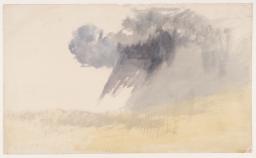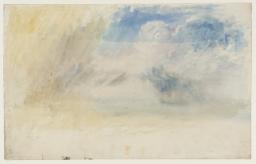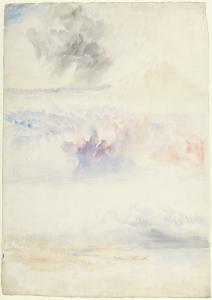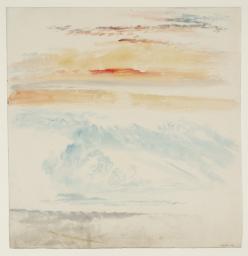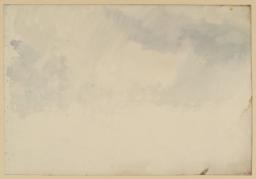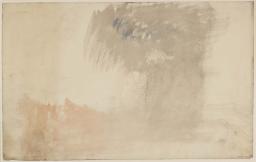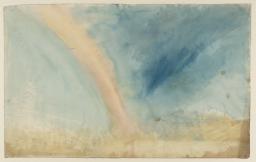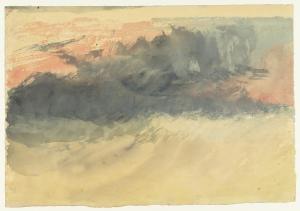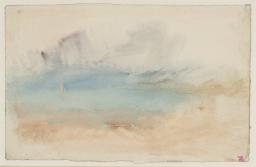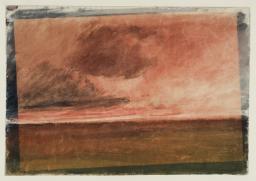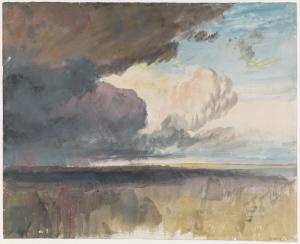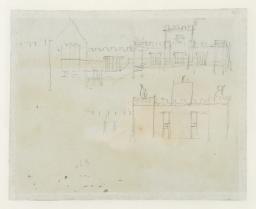Turner Bequest CXCVI R, CXCVII G, CCLXIII 71, 80, 119, 122, 131, 139, 140, 149, 165, 174, 236, 280, 292, 330, 337, 337v, CCCLXIV 35, 36
This subsection comprises ‘colour beginnings’ predominantly characterised by their focus on clouds in various conditions from calm sunshine to rainstorms. Most include a band of relatively nondescript land or sea, not developed enough for them to be included in sections elsewhere in the present catalogue such as the present author’s ‘England and Wales Colour Studies c.1825–39’ or John Chu’s ‘Coastal Scenes and Shipping’ after 1827.1
In 1803 the London manufacturing chemist Luke Howard (1772–1864) published his paper On the Modification of Clouds (Philosophical Magazine, vol.XVI) and expanded on his observations in the two volumes of The Climate of London (London 1818–20); he introduced the Latin-based terminology of ‘stratus’, ‘cumulus’, ‘cirrus’ and ‘nimbus’ and compound variations such as ‘cirrostratus’ and ‘altocumulus’ which are still used to categorise and differentiate cloud formations.2 Turner’s contemporary John Constable (1776–1837) is thought to have known of the latter publication and in may have influenced his study of clouds in the following decade (see for example Tate N06065).3 It is not known whether Turner would have been aware of Howard’s classifications in specific terms, nor are most of the studies here ‘scientific’ enough to be categorised according to the new system, but he was said to have studied the sky directly from a young age (see the overall Introduction to this section) and had a general informed interest in scientific developments.4 The clouds depicted here were presumably mostly recollected in the studio, although as noted in the overall Introduction, Turner often drew clouds directly in detailed annotated pencil sketches, along with other meteorological, solar and lunar effects.
Finberg dated the whole of his main ‘Colour Beginnings’ section (Turner Bequest CCLXIII) to around 1820–30,5 but those selected here are here given a broader range of 1820–40, except in cases where a watermark provides a terminus post quem. This reflects the artist’s production of similar ‘colour beginnings’ in relation to various dated projects during the 1820s and 1830s. Exceptions are D35874 and D35875 (Turner Bequest CCCLXIV 35, 36), which appear to be somewhat later.
It should be noted that Clouds over a Low Horizon (Tate D25499; Turner Bequest CCLXIII 375b), in other respects a candidate for the present section, has been included with the ‘Lowland and River Colour Studies c.1820–40’ on account of its sharing an undivided sheet with Trees by Water at Dawn or Sunset (Tate D25498; Turner Bequest CCLXIII 375a).
Note: In the course of ongoing research, Caitlin Doley’s entries for two generic watercolour studies of rainbows (D17182, D17197; CXCVI R, CXCVII G), likely from a few years earlier, have joined the sole previous example (D25296; CCLXIII 174) in this grouping; others, featured in more specific settings elsewhere in this catalogue, are noted under D17197.
The author is also very grateful to fellow Tate Turner cataloguers Alice Rylance-Watson and John Chu for intensive discussions in late October 2014, when the contents of the sections of separate sheets then remaining to be catalogued were largely drawn up.
See for example ‘Cloud names and classifications’, Met Office, accessed 15 March 2016, http://www.metoffice.gov.uk/learning/clouds/cloud-names-classifications .
See Jim Burton, ‘Howard, Luke (1772–1864)’, Oxford Dictionary of National Biography, accessed 15 March 2016, http://www.oxforddnb.com/view/article/13928 .
Revised August 2024
How to cite
Matthew Imms, ‘Colour Studies of Clouds, Storms and Rainbows c.1815–45’, subset, March 2016, in David Blayney Brown (ed.), J.M.W. Turner: Sketchbooks, Drawings and Watercolours, Tate Research Publication, November 2016, https://www

